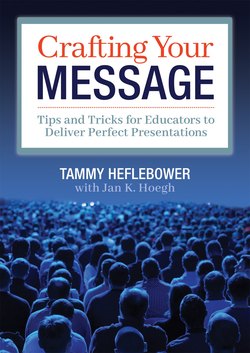Читать книгу Crafting Your Message - Tammy Heflebower - Страница 7
На сайте Литреса книга снята с продажи.
ОглавлениеIntroduction
It was January. I had been in my role as an author and trainer at a renowned research company for three months, and I’d been asked to conduct my first keynote. The location—Montréal, Québec, where French is the primary language. I needed to learn not only about a new educational system but also about another country’s existing approach to my controversial topic of effective grading practices. During my keynote, I stood behind a podium, stiff and stern. I had memorized my presentation. In my delivery, I used limited inflection, my pacing was too fast, and I had to pause for the information to be interpreted and understood. There was no physical space for interactivity, so I aborted such infused experiences. The topic, a philosophical shift for the audience, was another hurdle. When my address was over, the audience was polite, yet I knew it certainly had not been a home run. Rather, it was maybe a dive into first base after a struggle at bat. Afterward, I reflected. I learned. I revised. I committed to getting better, much better.
Selling your ideas is grueling! Whether you are presenting to a board, a team, or your staff, during a teleconference, or at an informal gathering, conveying and selling a poignant, memorable message takes specific knowledge and skills. Do you know these skills? Do you have them? Whether you are interested in capitalizing your skills as an educational speaker (an instructional coach, principal, professional developer, or superintendent) or whether you are a professional from another field seeking to learn and enhance presentation and facilitation skills, this book is for you!
This resource presents the culmination of my key learnings over the course of two decades of full-time public speaking, including training and speaking engagements, both nationally and internationally. I have presented to a myriad of audiences, which include local, state, and national boards; CEOs; service clubs; administrators; parents; business constituents; and trainers or facilitators.
This book is divided into two distinct parts: (1) tips for preparing for, delivering, and reflecting on your message, and (2) processes, protocols, and strategies to implement in your presentations.
Throughout the first part of this resource, each chapter focuses on a particular element of making a successful presentation and its many derivatives. Chapter 1 describes the important considerations and needs of adult learners. Thoughtful planning questions, as well as an organizational quadrant, help novice and expert presenters reflect about the meaningfulness and purpose of the message itself. Chapter 2 embodies essential elements of content, training formats, group-size characteristics, and considerations for planning short- and long-term work. The next few chapters highlight considerations for how to deliver a quality message. Chapter 3 describes important considerations for setting the stage—room arrangement, use of sound, managing the audience, centering yourself, and preparing the all-important speaker’s toolkit. Whether you are a novice or an expert presenter, thoughtful planning solutions will help you improve your approach and messaging. Chapter 4 embodies essential elements for three types of introductions: (1) informal, (2) formal, and (3) topic-based. The plethora of considerations for a dynamic delivery of your message is the focus of chapter 5. It discusses attention-grabbers, voice control, presenter behaviors, engagement, visual enhancements, and webinars. Chapter
6 describes tips for designing visuals and print materials to use in your presentation, including slides, handouts, and concerns when presenting via a visual medium. Chapter
7 emphasizes the importance of obtaining and using feedback from your audiences. It establishes the importance of feedback by highlighting current research, and provides suggestions to assist with obtaining feedback that is specific, timely, and the appropriate amount. Chapter 7 also provides helpful reflective progressions that you may use for planning and reflecting on your presentations. Chapter 8 concludes part 1 by featuring various presenter tips, tricks, and troubleshooting strategies, such as how to cope with a difficult audience or audience member.
Part 2 takes a different tone as it presents new, useful strategies you can incorporate to optimize your presentation and fully engage adult audiences. Chapters 9 through 14 provide processes and strategies in the areas of team building, triggering thinking, processing and practicing content, consensus building, summarizing, and checking for understanding. The appendix contains useful technology links to enhance your presentations.
It is important to note that the essence of this educational resource is based on and quoted from the series of published works by Dr. Tammy Heflebower, found in Presenting Perfected: Planning and Preparing Your Message (2018); Presenting Perfected: Dynamic Delivery (2018); and Presenting Perfected: Feedback, Tips, Tricks, and Troubleshooting (2019). While those books focused on tips for all presenters, this book has been adjusted to focus on presentations by educators. Additionally, the processes, protocols, and strategies included in part 2 are entirely exclusive to this volume. I hope this culminated resource will assist you in becoming the best public speaker you can be. Go—be great!
